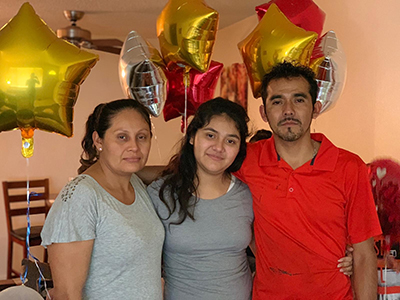The number of immigrants detained by U.S. Immigration and Customs Enforcement (ICE) has reached unprecedented levels in recent months. NIJC’s Detention Project staff, who provide legal rights information and representation to immigrants and asylum seekers detained at county jails in Illinois, Wisconsin, and Kentucky, see first-hand the harm caused by such widespread and unnecessary incarceration of immigrants, including parents and young adults, and by the Trump administration’s refusal to release them while they seek legal protection. NIJC’s four-part series, “Getting Out,” highlights the experiences of NIJC legal staff and clients trapped in the system. This story about ICE's arbitrary denial of humanitarian parole is the first in the series.
I first met Margaret* in April 2019 during a legal information session at the Illinois county jail where she was detained. I was instantly struck by how small and young she looked; I was worried that she had been wrongfully placed in adult detention. While my colleague continued with the presentation, I pulled her aside to ask her some questions and figure out if there was anything the National Immigrant Justice Center (NIJC) could do to help.
I asked her how old she was and I learned that she had turned 18 two months before, but she was still 17 when she and her family were forced to leave Mexico. A cartel with a stronghold in their community had given them less than 48 hours to leave or be killed. They sold what they could and made their way to the border, where they sought safe passage to the United States with the help of a human rights organization. They waited two months before they were allowed to present themselves at the border and request asylum.
Parole denial and family separation

After Margaret’s family was permitted to enter the United States, they were questioned by U.S. Customs and Border Protection officers and requested asylum. They also told officers that Margaret had just turned 18. Soon afterward, a guard told Margaret to grab her things. She had only a few seconds to say goodbye to her parents. They hugged her and cried, and the guard pulled her away. Margaret was sent to another detention center in Texas. Her father and brother who had a disability, and her mother and younger siblings, were held at separate hieleras before being sent to Chicago, where U.S. Immigration and Customs Enforcement (ICE) eventually released them on humanitarian parole.
Humanitarian parole is a temporary permission to remain in the United States, which ICE can grant to someone who is deemed to have a compelling reason or urgent humanitarian need. Margaret’s story reflects how ICE grants parole — while the rest of her family received parole, she was denied solely because she had just turned 18.
No one explained to Margaret why she was being separated from her family. She remained detained in Texas for several weeks. She described being there as “constant lock down.” Every time Margaret thought about her family she started crying, until another immigrant detained with her told her something that changed her perspective: “Think about it this way: you have already made it this far, you are safe, [your family] is safe, and you’re going to get a chance to fight your case. That’s more than some people ever get.”
Holding on to this advice, Margaret had just started to get used to her new reality in Texas when again, without notice, she was moved, this time to Pulaski County Detention Center in southern Illinois, and then a few weeks later to McHenry County Jail, in Woodstock, Illinois, about 60 miles northwest of Chicago. The only thing that kept her strong was realizing that the closer she got to Chicago, the closer she was to her family.
I struggled with how to explain that their reunion may still be far in the future. Margaret would not be eligible to be released from detention on bond because she had presented herself at the bridge rather than entering without inspection. I explained that though NIJC could help her ask a judge to grant her parole like the rest of her family, we had seen few parole grants out of the Chicago Immigration Court in the past year. There was a strong possibility that she would have to fight her case from detention. She seemed to understand, and after asking a few more thoughtful questions, she rejoined the group listening to the legal information presentation. I talked to many more people that day, but Margaret’s case stayed with me.
Mumps and chicken pox
It was a while before I was able to speak with Margaret again. Several cell blocks had been quarantined to control a mumps outbreak. Margaret was in one of the quarantined blocks. Legal aid groups are not permitted to enter quarantined facilities, and our ability to contact Margaret by phone was restricted. After the mumps quarantine ended, I tried to schedule a call with Margaret, but there was already another quarantine in place for a chicken pox outbreak. It was weeks before I was able to talk to Margaret, valuable time lost when she could have received assistance with her case.
Toward the end of May, I got a phone call from Margaret’s dad—her family had been worried about her since their separation, but was still trying to get the money together for an attorney for their cases. Months passed, but without much guidance, they felt as lost as ever trying to navigate the system that had caused them so much pain.
That same day, the jail lifted its quarantine. I set up a call with Margaret to see what had happened with her case. It turned out she’d had an unexpected court hearing that day to make up for a hearing that had been postponed due to the quarantine. Detention was becoming too much for her, so with the help of some other women in the detention center, she had submitted a skeletal asylum application to the court.
Facing court alone
Immigration cases move much more quickly for people who are detained than for those seeking legal relief outside of detention. As soon as a detained person submits an application for relief, the immigration judge can schedule the case for a final hearing. Margaret’s final hearing, where she would be expected to present her whole argument for why she needed asylum, was scheduled for the very next month. This meant that Margaret had less than a month to gather evidentiary materials for her case.
“It was Margaret. She did it all on her own. She was very brave."
I called Margaret’s dad to update him. He was scared. I tried my best to reassure him that the best thing we could do was to think of ways to corroborate his family’s asylum claims and collect as much evidence as possible within the short time frame. Within days he sent me all the documents I requested.
As Margaret’s court date grew near, NIJC’s detention team worried we would not be able to place the case with a volunteer lawyer on such short notice, so I sent her a thick packet of information and resources I hoped would be enough to help her succeed. It included a letter advising her of the weaknesses and strengths of her case, information about how to present her case in court without representation, the country conditions research I had gathered, and all the documents her dad had sent me. I checked in frequently with Margaret and her dad as the hearing date approached.
The day after the hearing, I checked the Executive Office for Immigration Review’s hotline to find out what had happened. To my relief, the automated system stated that Margaret had been granted asylum. Later that afternoon, I also received a picture from Margaret’s dad of the family’s reunion, with a note of thanks. I replied: “It was Margaret. She did it all on her own. She was very brave. We’re all so happy for her.”
Margaret later told me that the final hearing was very quick. She presented the materials her dad had helped compile, and she explained the persecution she would face if she had to return. When the immigration judge granted her case, she told Margaret she was too young to go back to Mexico on her own, and welcomed her to the United States.
The future
When I called Margaret a month after she was released, I could hear her little siblings yelling and laughing in the background. She put her little brother on the phone, and I asked if he had missed his sister. He yelled something unintelligible. Margaret came back on the phone and explained, “He says yes, but who knows.” She was laughing too. She sounded so much better.
This is not the end of their story. Margaret’s family still has not been issued court dates for their pending asylum cases on the non-detained docket. Finding a lawyer they can afford will be critical because if anything goes wrong with their cases, the family could be separated again in the future.
Nothing was gained by the trauma the U.S. government put Margaret through when it refused to grant her parole and kept her locked up away from her parents and siblings. Despite all the roadblocks put in front of her, she persevered. She is making plans for the future now. She wants to finish high school since she didn’t get to finish in Mexico. After that, she’s not sure. But now she has time, and the safety she needs, to figure it out.
*I’ve used a pseudonym to protect Margaret ’s privacy.
Romelia Solano was a paralegal with NIJC’s Detention Project. She is now pursuing a doctorate in political science at the University of Notre Dame, where she is a graduate fellow in the Institute for Latino Studies.

